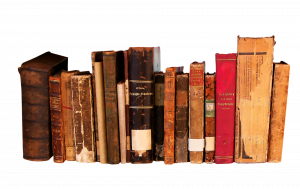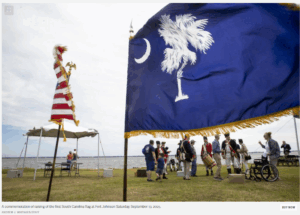BEAUFORT — When an unnamed family from Manhattan presented a silver cup to Sotheby’s New York in December, John Ward knew the auction house had received something special.
“The beauty and the importance of the cup as a piece of silver stands on its own,” said Ward, head of the Silver Department at Sotheby’s New York.
The cup, dated 1748, stands 13½ inches tall and weighs a touch less than 100 ounces. It features an ornate base, two handles topped with mythological figures and, importantly, an inscription connecting the English silver piece with events in Port Royal Sound nearly three decades before the start of the American Revolution.
Ward called the cup one of the most sophisticated pieces of rococo silver linked to the American Colonies. “As soon as I saw the inscription, the American tie was very exciting,” he told The Post and Courier.

Cynthia Jenkins, executive director of the Historic Beaufort Foundation, played a pivotal role in the effort to acquire the 275-year-old Hamar presentation cup after the item was listed for auction at Sotheby’s New York in January. Tony Kukulich/Staff
Ward wasted no time showing the piece to several colleagues at Sotheby’s. By incredible coincidence, one of them, Libby Cohen Davis, is from Beaufort. Not only did she understand the reference to Port Royal in the cup’s inscription, she was familiar with the Historic Beaufort Foundation.
Before Christmas, Ward jotted off a letter to the executive director of the foundation, Cynthia Jenkins, letting her know the cup would go to auction Jan. 23.
While very familiar with the events memorialized by the cup, Jenkins was completely unaware of the cup’s existence. After speaking with leading authorities on Beaufort County history, she realized she wasn’t the only one.
“Nobody knew it existed,” she said.
But once apprised of it, Jenkins was determined to bring the cup home to Beaufort, where its story got its start.
Pirates harass the Sea Islands
The cup is a reminder of a wilder time, when pirates plied the seas, and the battle to determine the future of the New World had yet to be decided.
In the definitive “History of Beaufort County, South Carolina, Volume 1, 1514-1861,” authors Lawrence Rowland, Alexander Moore and George Rogers Jr. wrote that Spanish and French privateers “ravaged South Carolina commerce and terrorized Sea Island planters.”
Rowland, a distinguished professor emeritus of history for the University of South Carolina Beaufort, explained that naval warfare between English Carolina and Spanish Florida had waged for nearly a century.
In the 1740s, the conflict intensified along the coast from Charleston to St. Augustine, Fla. The Colonial government was desperate to rid the area of pirates who were strangling the region’s economic prosperity.
“This decade of warfare was very costly to Charleston,” Rowland said. “The merchants and politicians in South Carolina had been hammering on the Royal Naval to get some ships out here to drive the pirates away.”
The threat is real, and deadly
The threat posed by pirates went beyond economic concerns. For residents of the coast, it could be a life-and-death matter.
A story relayed in “The History of Beaufort, South Carolina” illustrates the point.
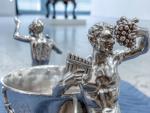
An Irish renegade known only as Collings worked with a French privateer named Capt. Barnard. The exceedingly successful pair captured 16 ships off the South Carolina coast before Collings was imprisoned in Charleston.
Living up to his renegade reputation, Collings burned down the Charleston jail to make his escape. He traveled through Beaufort to rejoin Barnard in St. Augustine. The pair were rumored to be planning a raid against the Sea Islands in which they would plunder and burn plantations.
Residents of St. Helena Island were so fearful that they proposed constructing the first bridge to connect St. Helena Island with Lady’s Island. The bridge, they argued, would give the residents an escape route should Barnard, Collings and crew come ashore.
It’s unclear if the pair launched their attack, which was expected to start in the spring of 1748. Fortunately for St. Helena Island residents, the timing coincided with another important event: The Royal Navy began its campaign to end the pirate threat once and for all.
Leading that campaign was Capt. Joseph Hamar aboard the formidable HMS Adventure.
Capt. Hamar arrives
Hamar sailed into the Port Royal Sound in late 1747 intent on protecting the colonial settlements and ridding the coast of the marauding pirates.
While the Charleston merchants would have preferred the Adventure dock near them, the shallow waters of Charleston Harbor were ill-suited for a warship of the Adventure’s size. The deep-water harbor of the Port Royal Sound was a better option.
The 40-gun Adventure was a large and fast ship of the line that was a match for any three Spanish ships, Rowland said. Its mere presence was enough to discourage piracy. Operating in the area from the Port Royal Sound for about a year, Hamar and his crew swept the seas clean.
To keep the pirates at bay, Hamar also established the Royal Naval Station at Port Royal on the Beaufort River.
“Having the the Royal Naval here permanently pushed the Spanish privateers back,” Rowland said. “By the end of the decade, the English dominance in the naval warfare had been established.”
As is still the case today, a permanent military installation created economic benefits of its own for Beaufort. The base brought jobs and commerce.
“It meant English silver shillings circulating in town,” Rowland said. “It was a big deal in this 100-year war between Carolina and Florida.”
What’s known about the cup
As an expression of thanks to Hamar, an up-and-coming London silversmith named Thomas Heming was commissioned to create a cup for the sea captain. The young man was so skilled that, several years later, Heming would be named the official goldsmith to the King of England.
Silver expert Tom Savage from Colonial Williamsburg praised Heming’s craftsmanship.
“This is the work of a young, ambitious guy who is really going to make his mark in the silver world,” Savage said. “I think you feel that bravura coming through in the design and the ornamentation of the cup. This is not an off-the-shelf piece.”
The cup’s inscription says Heming’s commission came from the “Gentlemen of Port Royal,” but their identities are not known.
Benjamin Schaffer, adjunct professor at the College of Charleston, is conducting research to see if they can be identified. He said they were probably merchants or plantation owners who were glad to be rid of the pirates.
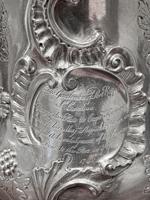
“We don’t know if the cup was presented to Hamar here or back in London,” Jenkins said. “We don’t know if it’s ever been to Beaufort.”
Hamar had the cup in his possession until his death in 1773. It was mentioned in his will and bequeathed to his daughter.
While research into the cup’s history is still ongoing, the next known reference to it came 110 years ago when it went up for auction in London. At the time, it sold for about £470, the contemporary equivalent of $70,000.
The cup did not appear again in the public record until December.
Daniel Ackermann, chief curator at the Museum of Early Southern Decorative Arts, was previewing items before the January auction when the Hamar cup caught his attention.
“It just really jumps out at you,” Ackermann said. “It physically has heft. It’s a big and heavy thing.”
Ackermann was so struck by the piece, he returned to Sotheby’s a second time and spent an hour examining it.
“It occupies space really beautifully,” he added.
The cup goes to auction in New York
After receiving Ward’s letter, Jenkins’ began discussing the cup with the board of the Historic Beaufort Foundation. The board gave her the go-ahead to make a play for it.
With just a few weeks before the auction, donors pledged money to support the purchase of the cup. Sotheby’s estimated its value between $15,000 and $25,000, though the opening bid was $9,000.
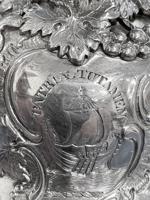
Ward said a Southern museum and a major player in the silver trade were also bidding on the cup. The museum dropped out early.
“There was one person who kept bidding against us,” Jenkins said. “It was up to $25,000. It was up to $28,000. It was getting pretty scary.”
Weeks of hurried planning and fundraising would come down to a bidding contest that was all over in little more than 60 nail-biting seconds. When the auctioneer’s gavel came down, the Historic Beaufort Foundation was the new owner of Hamar’s cup.
Jenkins had outlasted the competition.
She declined to discuss the winning bid, saying the item was priceless and not for sale. She specified that funding for the bid came from donors, and foundation funding was not used.
According to Sotheby’s, the final bid was $45,000. A 26 percent buyers premium brought the final price to $56,700.
“It was hard fought for,” Ward said.
Part of a bigger story
Hamar remained in the Port Royal Sound for a fairly short time, but his presence can still be felt after nearly three centuries. To this day, the city of Beaufort’s Hamar and Adventure streets commemorate the events of the 1740s.
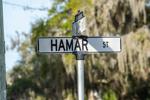
Named for Capt. Joseph Hamar of the British Royal Naval, Hamar Street was added to the layout of Beaufort in recognition of the captain’s role driving pirates from Port Royal Sound. Tony Kukulich/Staff
As for his cup, plans are being made to ship it to Beaufort. According to Jenkins, the cup will be securely stored until permanent plans for its display can be made.
Those who want to learn more can hear Rowland speak on the history of the cup during the Historic Beaufort Foundation annual meeting scheduled for April 19 at University of South Carolina Beaufort Center for the Arts. Jenkins hopes to have the cup on display for the meeting.
“It’s an artifact of a bigger story,” Rowland said.
Viewers can see a stunning silver cup — or they can see Hamar and his crew sailing the HMS Adventure from the Port Royal Sound, clearing the coastal waters of pirates and privateers that had for years terrorized Sea Island residents and suppressed economic prosperity all the way to Charleston.


